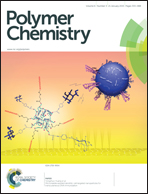One-pot approach to prepare high-performance graphene-reinforced poly(vinyl chloride) using lithium alkyl as covalent bonding agent†
Abstract
A novel one-pot approach has been demonstrated for the preparation of poly(vinyl chloride) (PVC)/graphene nanocomposites based on the grafting reaction of PVC chains to graphene using n-BuLi as an initiator. The grafting reaction was successfully confirmed by FT-IR, XPS, TGA, TEM and ICP-OES. Raman measurements showed that the structural integrity of graphene framework was retained after surface functionalization, leading to the development of homogeneous nanocomposites with well-dispersed graphene in PVC matrix. Because of a strengthened interfacial interaction and improved dispersion of graphene in the resultant PVC/graphene nanocomposites, the graphene platelets could change their random alignment into oriented alignment parallel to the stretching direction with the movement of the matrix during deformation. As expected, the PVC matrix filled with very low loading of graphene showed significantly improved mechanical properties and electrical conductivity over their counterparts without n-BuLi treatment. The results show that it is very important to rationally and simultaneously control dispersion state, structural integrity of graphene and interfacial interaction between graphene and polymer matrix to fabricate high-performance polymer nanocomposites.


 Please wait while we load your content...
Please wait while we load your content...